|
The Folksy Art of
Painted Toleware
by Bob Brooke
During the 17th and 18th centuries, tinware in a
variety of forms—candleholders, trays, kitchenware, and more—could be
found in many homes. And while it was popular, it had a major
drawback—rust.
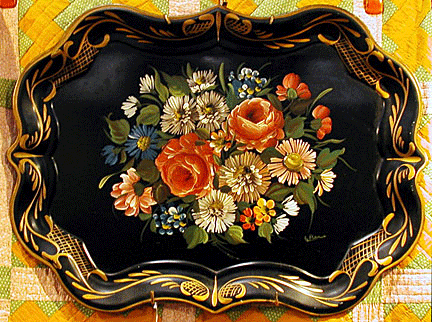
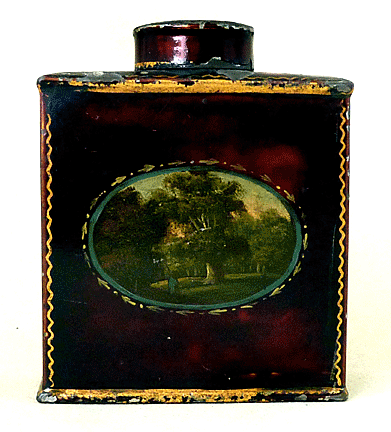 Welshman
John Hanbury discovered a way to prevent rust on tinware. He invented a
method of “japanning” tin so that it wouldn’t rust, a major breakthrough
in solving this common problem. He had a metalware business in Pontypool,
Wales, where he produced tin trays and other utilitarian objects that
were very popular. Hanbury coated the painted tin surface with a mixture
of asphalt and shellac and named the process “japanning” because the
glossy surface resembled the lacquer on Japanese trays. Welshman
John Hanbury discovered a way to prevent rust on tinware. He invented a
method of “japanning” tin so that it wouldn’t rust, a major breakthrough
in solving this common problem. He had a metalware business in Pontypool,
Wales, where he produced tin trays and other utilitarian objects that
were very popular. Hanbury coated the painted tin surface with a mixture
of asphalt and shellac and named the process “japanning” because the
glossy surface resembled the lacquer on Japanese trays.
Instead of tin, Hanbury made his trays and other pieces of painted
pewter, making them quite expensive. Distinguished by lacy openwork
rims, Pontypool toleware trays are still some of the most sought after
by collectors. His intention was to imitate the exotic lacquered items
from Japan. Makers of toleware from this time was most often decorated
their pieces in the chinoiserie style, depicting Asian scenes on a black
background.
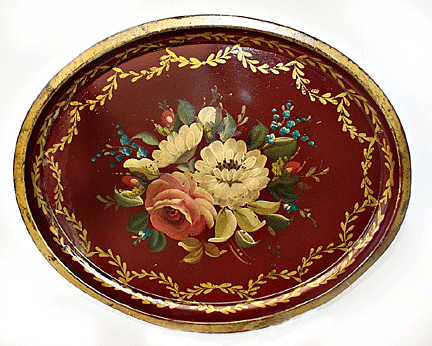 Eventually,
the French created their own version of toleware called “Tole Peinte du
lac,” French for “painted sheet metal. Using a superior varnish such as
vernis martin, they designed and created true works of art, using bright
colored backgrounds with a variety of decorations. They produced stately
urns, jardinieres, and trays, each carefully hand painted by artists. And
while toleware began as a way to prevent common household objects from
rusting, but eventually became an folk art form of its own. Eventually,
the French created their own version of toleware called “Tole Peinte du
lac,” French for “painted sheet metal. Using a superior varnish such as
vernis martin, they designed and created true works of art, using bright
colored backgrounds with a variety of decorations. They produced stately
urns, jardinieres, and trays, each carefully hand painted by artists. And
while toleware began as a way to prevent common household objects from
rusting, but eventually became an folk art form of its own.
Toleware in the United States
By the early to mid 18th century, the English had begun to manufacture
painted tin, which they shipped to the Colonies. As with many imported
items, American tradesmen and artists soon began to produce toleware.
Irish brothers Edward and William Patterson, who had settled in Berlin,
Connecticut in 1740, made hand shaped cooking utensils which they sold
door to door. A 1749 English law forbade the production of tin in
America, so initially they imported it from England, even with importing
costs, their business flourished.
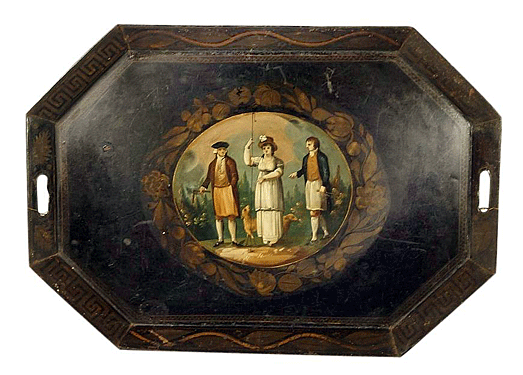
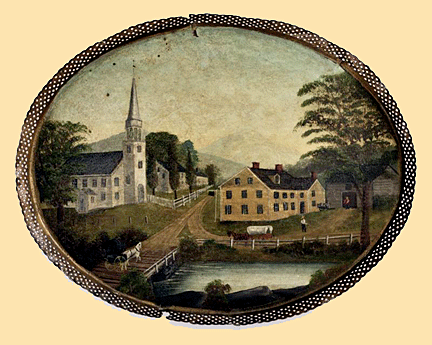 After
the American Revolution, Colonial tinsmiths made beautifully hand
painted trays for the wealthy, and shiny, unpainted and uncoated trays
for those with lower incomes.. After
the American Revolution, Colonial tinsmiths made beautifully hand
painted trays for the wealthy, and shiny, unpainted and uncoated trays
for those with lower incomes..
By the late 18th century, tinsmiths decorated their wares before selling
them. Family workshops in Connecticut, Maine, New York and Pennsylvania
produced toleware for sale. The men worked the tin and sold it after it
was finished by the women who “flowered” or decorated the pieces with
beautiful hand painted designs.
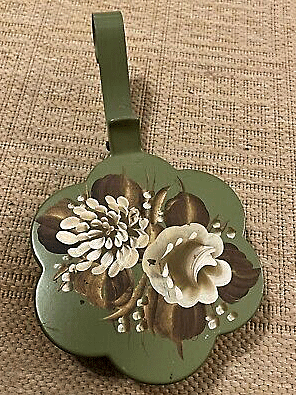 In
the 1950’s and 1960’s, American companies like Plymouth, Nashco, Pilgrim
and Fine Arts Studio produced trays that artists hand painted using an
assembly line method, using the distinctive one stroke method. An
experienced artist loaded a brush with one or more colors of paint then
applied it to the metal in a single stroke, creating shading and depth
to a flower, leaf or other decoration. Experienced artists, mostly men,
painted these “studio trays” were beautiful, and painted by accomplished
artists, mostly men. Some of the more famous artists from this time
period are Paul Dennis, Van, Fred Austin and Francis. In
the 1950’s and 1960’s, American companies like Plymouth, Nashco, Pilgrim
and Fine Arts Studio produced trays that artists hand painted using an
assembly line method, using the distinctive one stroke method. An
experienced artist loaded a brush with one or more colors of paint then
applied it to the metal in a single stroke, creating shading and depth
to a flower, leaf or other decoration. Experienced artists, mostly men,
painted these “studio trays” were beautiful, and painted by accomplished
artists, mostly men. Some of the more famous artists from this time
period are Paul Dennis, Van, Fred Austin and Francis.
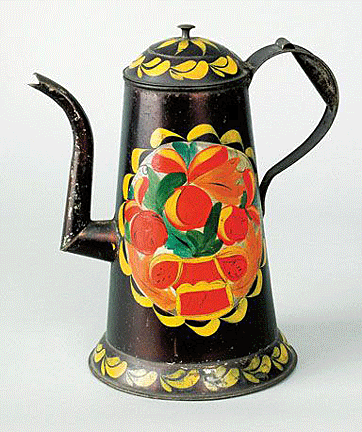 When
speaking of toleware, antique dealers and collectors refer to kitchen
objects created from metal, typically tin or thin steel, in decorative
styles such as Arts and Crafts and Pennsylvania Dutch. Though decorative
painting on these items is common, it isn’t necessary. When
speaking of toleware, antique dealers and collectors refer to kitchen
objects created from metal, typically tin or thin steel, in decorative
styles such as Arts and Crafts and Pennsylvania Dutch. Though decorative
painting on these items is common, it isn’t necessary.
Tray prices can range from $35.00 to thousands, depending on age,
condition, subject matter, and the quality of the painted decoration.
Some of the more popular pieces of toleware include shades for bouilotte
lamps and other candle shades, as well as trays and lidded canisters, in
which stenciling and gilding has been done on a black ground.
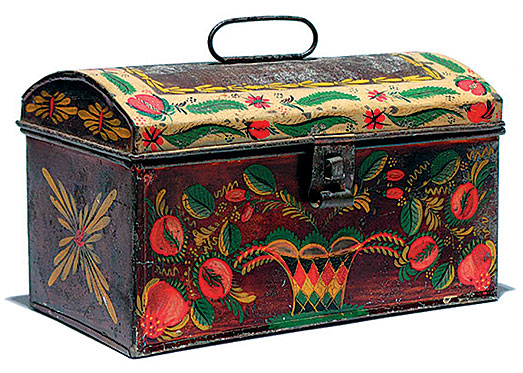
Collectors look for unusual colors, what they collect differs as much as
toleware pieces differ from each other. Some collect only Chinoiserie,
pieces with mother of pearl inlay, roses, only black trays, or only
French, or English, or American objects, for instance. Collectors look
for pieces that don’t have damage on the painted scenes or decorations,
these will always be more collectible and worth more than objects where
part of the hand painted embellishment is peeling or damaged.
< Back
to Collectibles Archives Next
Article >
|
